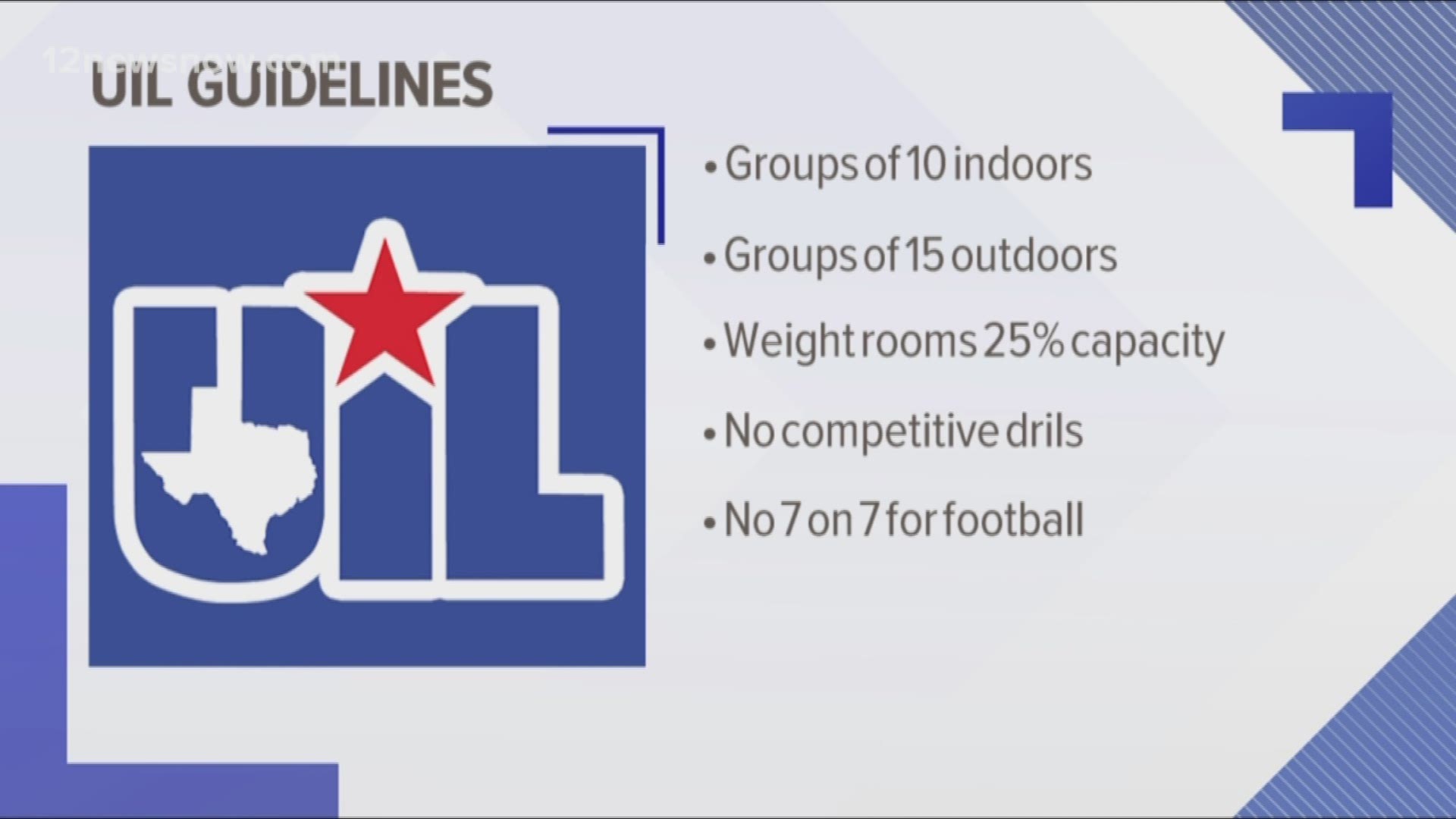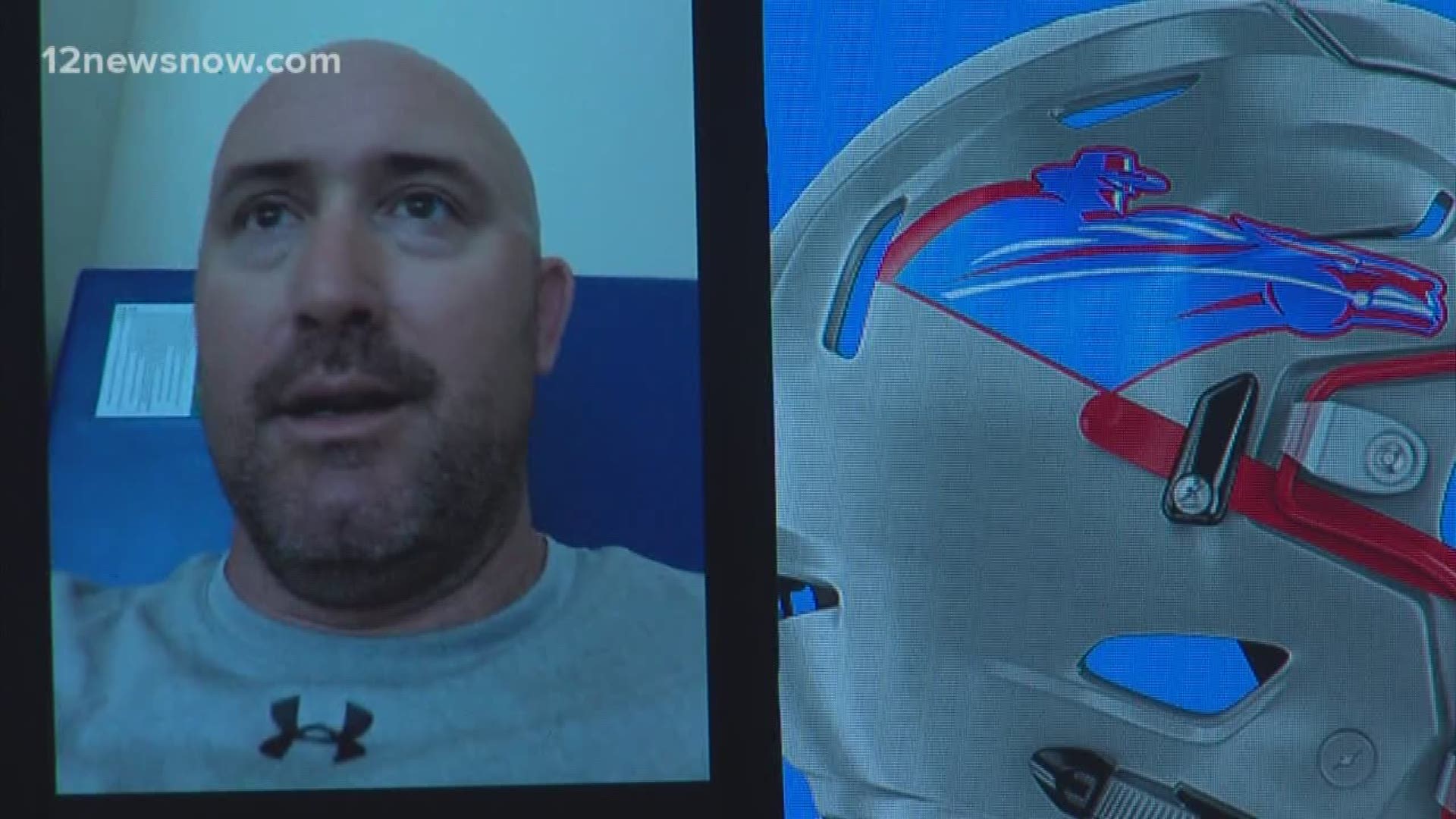BEAUMONT, Texas — The University Interscholastic League has released their guidelines for summer workouts that are allowed to start on June 8th.
As expected the list of guidelines is lengthy. Here's a look.
Requirements for all Workouts
Consider having an individual wholly or partially dedicated to ensuring health protocols are being successfully implemented and followed. Schools must follow all requirements of state and local authorities in addition to the requirements below:
- Attendance at workouts must be optional for students and in compliance with the rules for Summer Strength/Conditioning Programs & Sport Specific Skill Instruction noted below. In addition to on-campus workout options, schools should consider providing students guidance for working out at home or remotely away from school. This can include virtual workouts, emailed or otherwise electronically delivered workout instructions, or any delivery model approved by the local school district.
- Attendance records shall be kept, however, students shall not be required or allowed to make up missed days or workouts.
- Fees, if any, shall be established by the superintendent and collected by the school. Any payment to coaches shall be from the school and from no other source.
- Students may not be given access to locker rooms or shower facilities. Students should report to workouts in proper gear and immediately return home to shower at end of the workout.
- During workouts, schools must have at least one staff member per twenty students in attendance to ensure appropriate social distancing, hygiene, and safety measures are implemented.
- Schools must have hand sanitizer or hand-washing stations readily available in the workout area. Students and staff should be encouraged to use it frequently.
- All surfaces in workout areas must be thoroughly disinfected throughout and at the end of each day.
- No clothing or towels may be laundered on site or shared during workouts.
- There can be no shared water or food.
- Before the start of summer workouts, and at the start of every week of summer workouts, schools should consider pre-screening all students for COVID symptoms that they or others living in their house may experience. This can be completed by phone prior to the first day of workouts, in person or in writing. Students and staff must self-screen every day for COVID-19 symptoms for themselves and family members. Schools should consider taking the temperature of each student each day at the start of the conditioning sessions, if possible.
- Schools should plan for entry and exit procedures that reduce the number of students and parents congregating outside and/or mixing around the workout areas and parking areas. Consider staggering start and end times, assigning students to entries and exits to ensure even distribution of students entering/exiting at each entry point, providing guidance to students to enter one at a time and wait six feet apart outside the entrance.
- If the school is planning to offer transportation for summer activities, schools should follow all TEA guidance and local guidance related to such transportation.
* Schools should consider having students remain with a single group or cohort to minimize the number of students and staff that must isolate if a case is confirmed. See Positive Cases and Staff or Students Showing COVID Symptoms at the bottom of this document.
Strength and Conditioning Workouts
In addition to the above requirements for all workouts, the following applies to strength and conditioning activities:
- Sessions for strength and conditioning may be conducted by school coaches for students in grades 7-12 from that coach’s attendance zone.
- A strength and conditioning session shall be no more than two consecutive hours per day, Monday through Friday.
- A student shall attend no more than one session per day.
- Strength and conditioning sessions shall include only strength and conditioning instruction and exercises. No specific sports skills shall be taught and no specific sports equipment, such as balls, dummies, sleds, contact equipment, etc., shall be used.
- Except for reasonable safety considerations, such as spotting, students and staff must maintain at least six feet of distance from all sides when not actively exercising. When actively exercising, students and coaches must maintain at least ten feet of distance from all sides when possible. Schools should consider requiring students who are not actively exercising, but are spotting, to wear cloth face masks.
- Indoor workout activities can be conducted up to a maximum of 25% capacity.
- Schools should limit the total number of participants based on available space to allow for the appropriate distancing between students and staff.
- Workout stations must be spaced to allow for at least ten feet of distance between them in all directions. Some exercises may require more than ten feet of distance.
- Any equipment must be thoroughly disinfected before and after each use. If a student uses a piece of equipment, that equipment must be thoroughly disinfected before another student uses it. Schools should limit the use of equipment to further reduce the risk of spreading the virus.
Sport Specific Instruction
In addition to the above requirements for all workouts, the following applies to sport specific instruction:
Limitations and Rules
- Sessions for sport specific instruction may be conducted by school coaches for students in grades 7-12 from that coach’s attendance zone.
- Sessions may be conducted in addition to the strength and conditioning session(s), and a student shall attend no more than 90 minutes per day of sport specific skill instruction with no more than 60 minutes per day in a given sport, Monday through Friday.
- Sport specific skill sessions may include specific sports equipment, but contact equipment (restricted equipment) is not allowed. School shorts, shirts and shoes may be provided by the school (local school option) but may not be laundered on-site.
- No competitive drills involving one or more students on offensive against one or more students on defensive may be conducted.
- Examples (including but not limited to):
- Basketball players may participate in drills, but cannot conduct drills / activities against a defender.
- In football, offensive / defensive drills are allowed, but no 7 on 7, or offense vs defense drills are allowed, etc.
- Examples (including but not limited to):
Sport Specific Activities Conducted Outdoors
Risk Mitigation
- Students and staff must maintain at least six feet of distance from all sides when not actively exercising. When actively exercising, students and coaches must maintain at least ten feet of distance from all sides when possible.
- Schools should limit the total number of participants based on available space to allow for the appropriate distancing between students and staff.
- Students may be placed in working groups no larger than 15 total students. Each working group should maintain appropriate distance from other working groups.
- Any equipment, such as sports balls, should be regularly disinfected during workout sessions. This equipment should not be shared between groups. After a group has used such equipment, that equipment must be thoroughly disinfected before being used by a different group.
Sport Specific Activities Conducted Indoors
Risk Mitigation
- Students and staff must maintain at least six feet of distance from all sides when not actively exercising. When actively exercising, students and coaches must maintain at least ten feet of distance from all sides when possible.
- Schools should limit the total number of participants based on available space to allow for the appropriate distancing between students and staff.
- Indoor workout activities can be conducted up to a maximum of 25% capacity.
- Students may be placed in working groups no larger than 10 total students. Each working group should maintain appropriate distance from other working groups.
- Any equipment, such as sports balls, should be regularly disinfected during workout sessions. This equipment should not be shared between groups. After a group has used such equipment, that equipment must be thoroughly disinfected before being used by a different group.
Positive Cases and Staff or Students Showing COVID Symptoms
Instructions for COVID Symptoms
If a positive case is identified among a participant in these summer activities, either staff or student, the group to which that staff or student was assigned and in contact with must be removed from the sessions while all members of the group self-isolate. If the confirmed individual regularly had close contact outside a single group, then all of the students and staff with whom the confirmed individual had close contact shall be removed from workouts for two weeks.
- Schools should consider having students remain with a single group or cohort to minimize the number of students and staff that must isolate if a case is confirmed.
- For example: If a student in one cohort tests positive for COVID, the student and that one cohort must isolate. If that student was part of several cohorts, then the student and all of the cohorts they were a member of would have to isolate.
Any staff member or student who experiences any of the symptoms of COVID (listed below) should self-isolate until the below conditions have been met.
- In the case of an individual who was diagnosed with COVID-19, the individual may visit when all three of the following criteria are met: at least three days (72 hours) have passed since recovery (resolution of fever without the use of fever-reducing medications); and the individual has improvement in respiratory symptoms (e.g., cough, shortness of breath); and at least ten days have passed since symptoms first appeared; or
- In the case of an individual who has symptoms that could be COVID-19 and does not get evaluated by a medical professional or tested for COVID-19, the individual is assumed to have COVID-19, and the individual may not return to work until the individual has completed the same three-step criteria listed above; or
- If the individual has symptoms that could be COVID-19 and wants to return to work before completing the above self-isolation period, the individual must obtain a medical professional’s note clearing the individual for return based on an alternative diagnosis.
Any student or staff member living with someone who experiences any of the symptoms of COVID, whether they have a positive COVID test or not, should self-isolate for two weeks. If they do not experience any COVID symptoms during that period, they can return to summer workouts. If they experience symptoms, they must self-isolate until the conditions outlined above have been met.
COVID Symptoms for Screening
- Cough
- Shortness of breath or difficulty breathing
- Chills
- Repeated shaking with chills
- Muscle pain
- Headache
- Sore throat
- Loss of taste or smell
- Diarrhea
- Feeling feverish or a measured temperature greater than or equal to 100.0 degrees Fahrenheit
- Known close contact with a person who is a lab confirmed to have COVID-19


